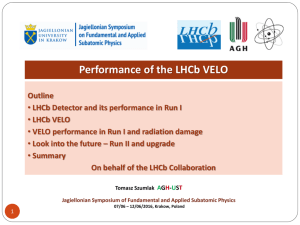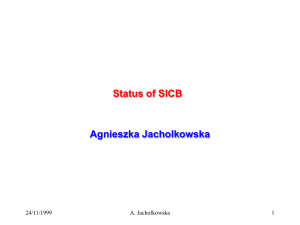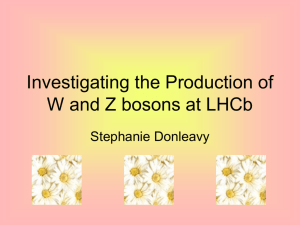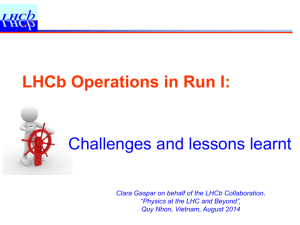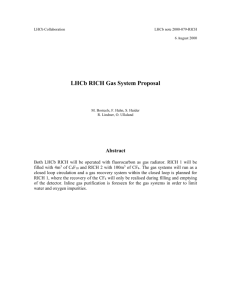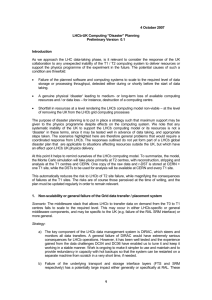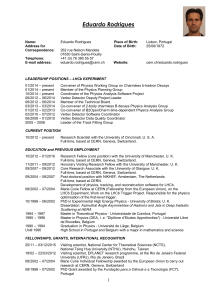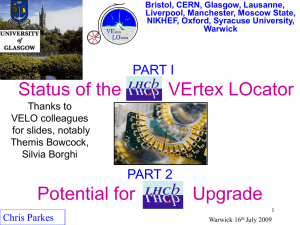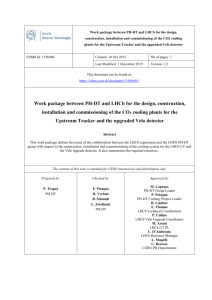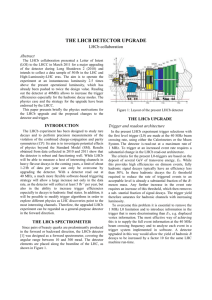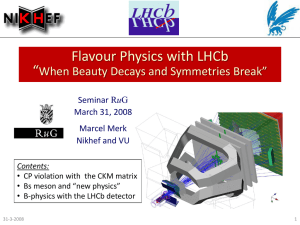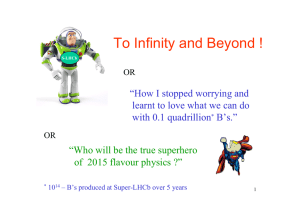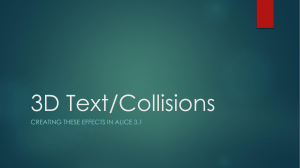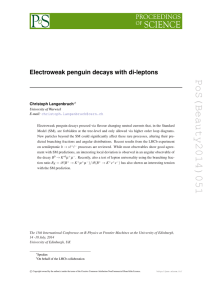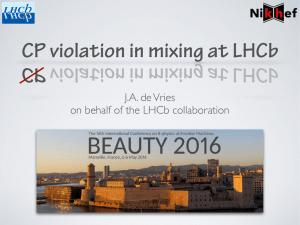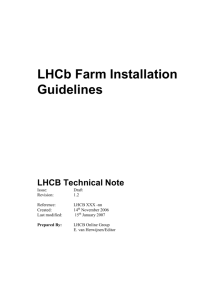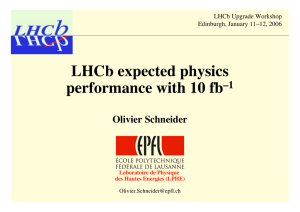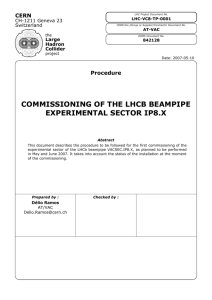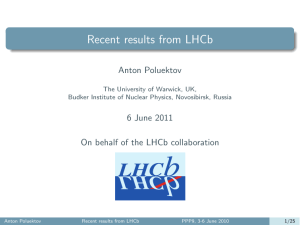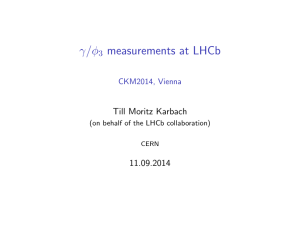LHCbGDR_16Dec2014
advertisement
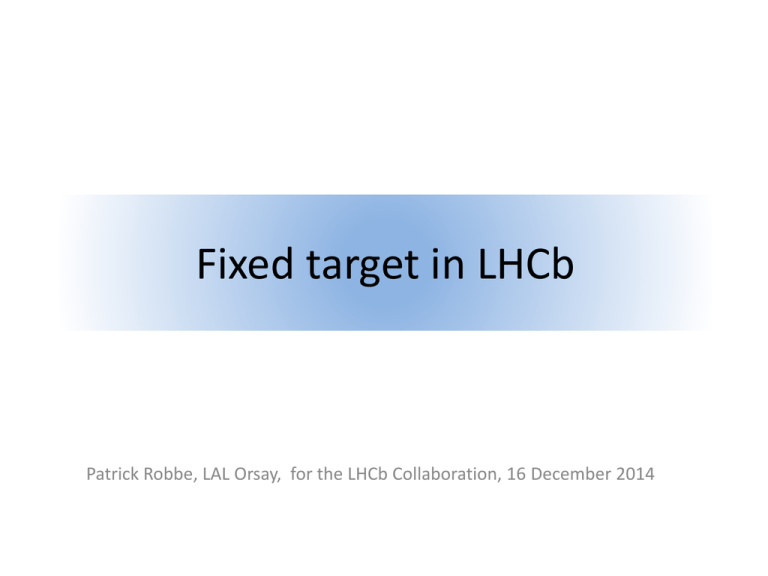
Fixed target in LHCb Patrick Robbe, LAL Orsay, for the LHCb Collaboration, 16 December 2014 Introduction • Between 2010 and 2013, LHCb took data in various configurations with LHC beams: – pp collisions at 2.76, 7 and 8 TeV center-of-mass energy – pPb and Pbp collisions at 5 TeV • But also in fixed target configuration: – pNe at 87 GeV – PbNe at 54 GeV 2 LHCb experiment • Fixed target experiment geometry • In the forward region: 2 < h < 5 3 LHCb VELO (Vertex Locator) • Device to measure precisely primary vertices and decay vertices (essential for CP violation measurements) • In the LHC vaccuum, 8 mm from the beam • Gas target (SMOG) is injected in the VELO 4 VELO Layout 5 LHCb luminosity measurements • To measure the absolute instantaneous luminosity of the LHC collisions in LHCb: beam imaging method: – A gas is injected in the VELO during dedicated periods (van der Meer scans) – From the beam-gas vertices, the shapes of the beams are measured – Lint = f N1N2/(4psxsy) • In normal data taking, the relative luminosity is measured using multiplicity counters calibrated during the scans. • The integrated luminosity is obtained summing these counters (with a 3% precision) 6 Fixed target system • The existing system to inject the gas for the luminosity measurement (SMOG) could be re-used for fixed targe physics: – Precise vertexing (and LHC filling scheme) allows to separate beambeam and beam-gas contributions – However strong acceptance effects as a function of z No beam One beam Two beams 7 SMOG For the moment, manual control system and no precise gas pressure measurement: is being solved. 8 Gas injection For the moment, only local and temporary degradation of vaccuum (~1hour), no longer injections so far 9 pNe collisions • For luminosity measurements, Ne gas is used • Data recorded was analysed • Dy ~ 4.5: LHCb covers the backward region in the nucleonnucleon centre-of-mass frame 10 PbNe collisions • Run taken in 2013 (27 minutes), with low multiplicities • Clean light hadron signals visible: 11 Prospects • Target types: – H and noble gases (He, Ne, Ar, Kr, Xe). He, Ne and Ar already tested. • Luminosities: increasing the gas pressure with a factor 10 with respect to now: – pA ~ 10/(mb s) – PbA ~ 1/(mb s) • Operations: – No impact on LHC for short run observed in 2013 – Longer runs to be checked carefully – « Competition » with LHCb standard physics program: • No competition for PbA (apart from computing ressources): 1 month of data taking per year • Probably difficult to have gas injected during pp collisions: contamination of pp events and output bandwidth limitation (20 kHz after trigger in total). Could expect 1 week of dedicated pA run per year. 12 New detectors installed end of 2014 • Forward and backward (high rapidity) scintillator counters: • Increase the rapidity coverage to detect central exclusive processes with large rapidity gaps: gain for diffractive physics that can also be done with fixed targets. 13 More detailed look at PbAr collisions • Study done in collaboration with F. Fleuret (LLR), for charmonium production. • Using Ar as gas target gives densities similar to the densities of NA50 • In the nucleon-nucleon centre-of-mass frame, -2.2 < y*LHCb < 0.8. • Integrated luminosity of ~0.7 nb-1 in one month of data taking. 14 PbAr event display • Full detector simulation on a EPOS event 15 PbAr multiplicities • In most central collisions, ~10 times larger multiplicity than in a pp collisions. • Can LHCb work in higher multiplicity environment ? – With this factor 10, yes without doubt – High multiplicity is a problem for B physics analysis (CP violation) but much less for cross-section measurements – LHCb is already routinely running at 3 times higher luminosity than its design • Rate is also not a problem: LHCb will work with 20 kHz output rate (after trigger), for PbAr, the interaction rate is 4 kHz (before trigger). 16 J/y reconstruction prospects • From simulation studies (EPOS + Full detector simulation), expect 5x104 J/y reconstructed per year (ie 1 month running) with conservative gas pressure considerations. • No MB event selected in our (limited) simulation samples: >7 s signal for 1 year (ie 1 month running). Signal only (with underlying event) 100 LHCb Simulation 80 60 40 20 0 3000 3020 3040 3060 3080 3100 3120 3140 3160 3180 M(J/ y ) (MeV/c2) 17 LHCb upgrade plans • 2015-2018: Run 2 • 2018-2020: Upgrade LHCb detector and trigger system: – Only one software level of trigger running at 40 MHz, with higher luminosity – Improved tracking detectors (VELO with pixels, tracker with scintillating fibers) to cope with higher multiplicities • 2020-2030: record 50 fb-1 • After 2030: instantaneous luminosity too high for the detector, ideas for evolutions of LHCb after 2030 start to be designed now. 18 Conclusions • SMOG system allows fixed target physics program at LHCb • First tests and simulations successful • A lot of work still needed to move from test to real physics program (operation in particular) • At least, LHCb could be an ideal pilot experiment for future fixed target programs 19
